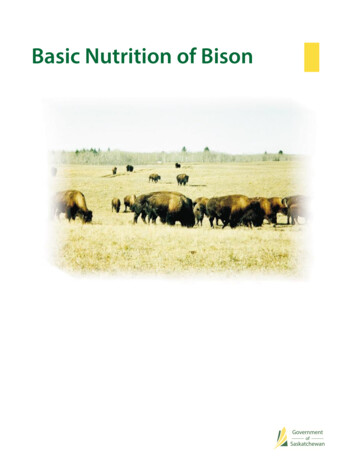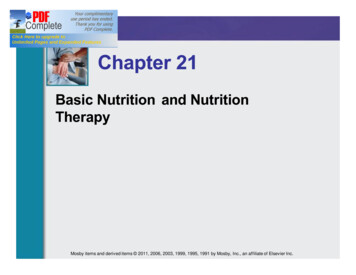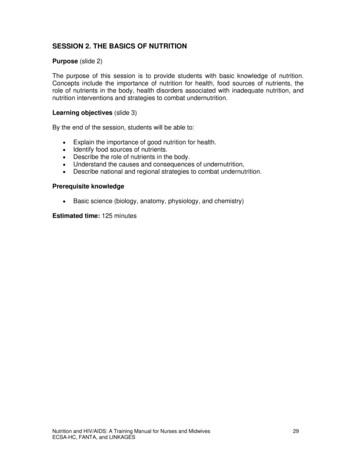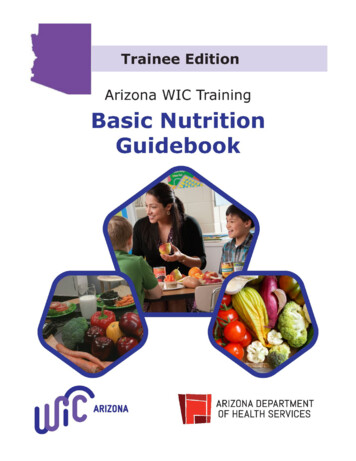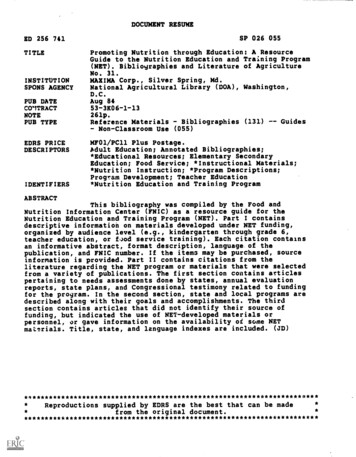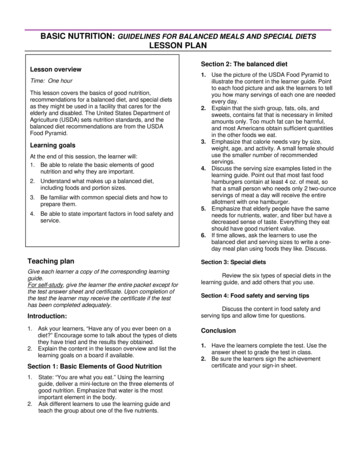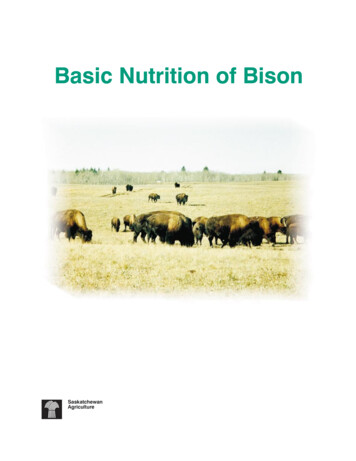
Transcription
Basic Nutrition of BisonSaskatchewanAgricultureand Food
TABLE OF CONTENTSLIST OF TABLES .iiFEED INTAKE, DIGESTIVE SYSTEM, AND SEASONAL PHYSIOLOGY . 1Introduction . 1Dry Matter . 1Dry Matter Intake . 1Factors Affecting Nutrient Requirements . 1Digestive System . 1Growth and Seasonal Physiology of Bison . 2Growth and Development of Calves . 2Seasonal Weight Changes of the Mature Cow . 2Seasonal Weight Changes of the Mature Bull . 4Metabolic Winter Weight Loss . 4THE BASIC NUTRIENTS . 5Water . 5Dugouts . 5Sloughs, Creeks and Springs . 6Snow . 6Wells . 6Water Quality . 6Energy . 8Energy Requirements of Mature Cows . 9Mature Bulls . 9Juveniles and grower/feeder calves . 9Crude Protein . 10Minerals . 10Macro Minerals . 11Micro Minerals . 11Vitamins . 12Effects of Stress . 12PRACTICAL FEEDING FOR BISON . 13Adults . 13Replacement Heifers . 13Breeding Bulls vs. Feeder Bulls . 13Differences between Cereal Grains . 14Mineral / Vitamin Supplementation . 14Summer Grazing . 15Pasture Supplementation and Flushing . 16Winter Feeding . 16Winter Swath Grazing of Annuals . 17Moldy Forages . 17Nitrates in Forages . 18REFERENCES . 19ACKNOWLEDGMENTS . back coveri
LIST OF TABLESTable 1. Dry matter intake of beef cows consuming high to low quality forages. . 1Table 2. Comparison of total tract retention time and dry matter digestibility of forages betweenbison and cattle. . 2Table 3. Winter vs. summer with respect to daylength, metabolism, dry matter intake and bodyweight status. . 5Table 4. Water quality guidelines for livestock use. . 7Table 5. Estimated energy, crude protein, calcium and phosphorus requirements of bison. . 8Table 6. Macro mineral function, deficiency and toxicity symptoms. . 10Table 7. Micro mineral function, deficiency and toxicity symptoms. . 11Table 8. Mineral and vitamin requirements for stressed beef calves and unstressed beef cattle. . 12Table 9. Acres/1000 lb. bison (or Animal Unit) based on 7 month grazing season, 30% carryover,30% creep-rooted alfalfa and 70% meadow bromegrass pasture in good condition. . 16Table 10. Acres/1000 lb. bison (or Animal Unit) based on 7 month grazing season, 50% carryover,and season long use of native range (Loam or Clay range sites). . 16Table 11. Nutrient levels of forages available to bison in sward sites, grazed patches, and actualfeeding stations. . 16Table 12. Variation in forage quality for alfalfa hay and grass hay. . 17Table 13. Common nutrient values for feeds in Saskatchewan. . 18ii
FEED INTAKE, DIGESTIVE SYSTEM, AND SEASONAL PHYSIOLOGYIntroductionMost of the information available on bison nutritionhas been extrapolated from beef cattle requirements,bison forage selectivity, current knowledge of the bisondigestive system and growth and seasonal adaptations.Specific energy, protein, mineral and vitamin requirements have yet to be fully developed. When feedingbison, several concepts must be understood: a)bison are ruminants, and all diets must be foragebased prior to considering the use of grain supplementation and b) weight loss will happen at certaintimes of the year and planning is required prior tosuch periods. Finally, it is important to read throughthis entire document prior to making any decisions on ayear round feeding program.on a dry matter basis. The value of 900 lb. wasachieved by multiplying 1,000 lb. x 90%. Conversely,900 lb. of alfalfa hay dry matter would equal 1,000 lb.as fed basis (900 lb. 90% 1,000 lb.). Conversionsbetween as fed and dry matter are necessary, not onlyfor estimating nutrient levels consumed but also forestimating actual as fed feed amounts required on adaily, monthly or yearly basis. Finally, all nutrientrequirements for ruminants are expressed on a drymatter basis.Dry Matter IntakeDry matter is important for other reasons. Total drymatter intake for ruminants can be estimated as apercentage of body weight. For beef cattle, dry matterintake will vary when consuming forages ranging inDry Matterquality (Table 1). As the forage fiber level increases,Dry matter (DM) is the weight of the feed once allthe digestibility of that feed decreases. This results inmoisture is absent. For example, alfalfa hay containing a reduced level of feed intake as the rumen requires a10% moisture (as fed basis) will have a dry matterlonger period of time to digest the fiber. Thus, thevalue of 90%. This is calculated by subtracting therumen stays full longer, reducing feed intake. Whilemoisture level in the feed from 100 (e.g. 100 - 10 Table 1 refers to cattle and cannot be directly related to90). Therefore, a bale of alfalfa hay weighing 1,000 lb. bison, it does show that predicted dry matter intakeat 10% moisture (90% DM) has a total of 900 lb. haychanges with changing forage quality.Table 1. Dry matter intake of beef cows consuming high to low quality forages.FeedExcellent Quality HaySilageVery Good HayMedium Quality HayPoor Hay, Barley StrawWheat StrawDry MatterDigestibility (%)6560-6560554535-50Per cent ADF(100 % DM)293636394954zDry Matter Intake(% of body weight)3.02.5 - 3.02.52.01.51.0zADF Acid Detergent FiberSOURCE: Saskatchewan Feed Testing Laboratory, 1990.Factors Affecting Nutrient RequirementsDigestive SystemBison are grazing ruminants that have a four chambered stomach for feed digestion. The first two stomach chambers are the rumen and reticulum. A bison’srumen is very structured, ensuring that forage basedfeeds are retained for long periods of time. As a result,bison only feed four to nine times a day, consuminglarge quantities of forage per feeding. In comparison,deer consume smaller quantities of feed more frequently throughout the day. Bison also retain feed intheir digestive system longer than cattle (Table 2).Longer feed retention means that bison have more timeto digest the fiber in feeds such as sedges and grasses.However, when consuming alfalfa or alfalfa bromehay, there is virtually no difference in digestibilitybetween bison and cattle because the fiber level in alfalfabased forages is typically lower than in grasses andsedges. Forages with lower fiber levels do not need tostay in the digestive tract as long to be fully digested ascompared to forages with higher fiber levels.The rumen and reticulum are populated with microorganisms such as bacteria and protozoa. These micro1
organisms utilize the fibers in forages and starches ingrains to produce acetic, propionic and butyric acids.These acids are absorbed through the wall of the rumeninto the blood stream to be converted into energy bythe liver. Forages contain higher levels of fiber andlower levels of starch than grains and when utilized bythe microorganisms, the amount of acid produced caneasily be absorbed.When suddenly introduced to high grain diets, themicroorganisms produce higher levels of acid.Higher acids levels can potentially result in liverabscesses, rumen ulcers, acidosis (otherwise knownas feedlot bloat), founder and even death.Picture of protozoa (large circle) surrounded by smallerbacteria in the rumen. Photo: Dr. G. Jones.The microorganisms also break down feed protein andnitrogen to create their own protein. This microbialprotein, as well as minerals and vitamins, are passeddown the digestive tract for absorption in the large andsmall intestines.Table 2. Comparison of total tract retention time and dry matter digestibility of foragesbetween bison and cattle.Total Tract Retention Time (h)Bison78.8Cattle68.7Dry Matter Digestibility (%)Sedge hayGrass hayAlfalfa/brome hay647450586252SOURCE: Schaefer, A. L., Young, B. A. and Chimwano, A. M. 1978Growth and Seasonal Physiology of BisonGrowth and Development of CalvesWhen born, most calves have a mid-May birth weightof 40 to 75 lb. and can gain 1.2 to 2.0 pounds per dayuntil weaning at 7 months of age (Figure 1). At weaning, an average weight of 400 pounds for heifer calvesand 500 pounds for bull calves should be achievableunder normal feeding and feed management conditions. From January to April, calf growth rate willvary depending on the feeding program. If fed a grainsupplement with a grass or legume hay, it is possiblefor bison calves to gain approximately 0.75 to 1.5pounds per day. Dry matter intake levels for calveswill range from 2.0 to 2.4% of body weight fromDecember to 18 months of age. Upon reaching 18months of age, a lifetime cycle of reduced dry matterintake and weight loss in the winter followed by higherdry matter intake and weight gain in the spring/summerwill occur.2Growth rate of calves depends on the feeding program.Seasonal Weight Changes of the Mature CowOnce bison reach 18 months of age, they begin alifetime cycle of winter weight loss followed by spring/summer weight gain. Figure 2 shows a typical weight
cycle and estimated dry matter intake for bison cowsthroughout the course of a year. From December toApril, it is not uncommon for mature bison to lose 10to 15% of pre-winter body weight. For example, a1,000 lb. cow in December will weigh 900 lb. in April,800a loss of 10% of body weight. Dry matter intake at thistime would be 1.4 to 1.8% of body weight. If greaterthan 20% of pre-winter body weight is lost, there isan increased risk for abortions, stillborn calves, orif calves are born, smaller and weaker calves.12 months old24 months old700600Weight mberAugustJulyJuneMay0MonthFigure 1. Weight curve for female bison from birth to 24 months of age.M a t u r e F e m a le B o d y W e ig h t1 0 0 0 lb1 0 0 0 lb9 5 0 lb9 0 0 lbB re e d in gW e a n in gC a lv in gD r y M a tte r I n ta k e ( % B o d y W e ig h t )2 .7 %2 .5 %2 .5 %D ecN ovO ctSepA ugJulJu nM ayA prM arFebJanD ec1 .6 %Figure 2. Seasonal weight changes of mature female bison.3
In the last 2 to 6 weeks prior to the calf being born, thefetus is rapidly gaining weight. This increases thenutritional requirements of the cow. Dry matter intakewill increase to 2.7 to 3.0% of body weight and willremain high to support the growth of the fetus. Oncethe calf is born in May or June, the weight of the cowwill be reduced by another 100 lb. (calf weight, placenta and fluids). Dry matter intake will remainhigh to support lactation.10 to 15% of their pre-winter body weight fromDecember to April due to a slower metabolism. Duringthis winter period, dry matter intake will range from 1.4to 1.8% of body weight. If grass hay diets are supplemented with grain, winter weight loss will be minimized,but compensatory gains in the spring and summer willnot be as great. During the breeding season, bulls canpotentially lose 10 to 15% of body weight again.Therefore, it may be necessary to provide extra energythrough supplementation to prevent too much loss ofbody condition. Excessive loss of body weight duringFrom May to August, lactation demands on the cowbreeding makes it more difficult for the bulls to regain aare slowly decreased. This is due to the calf becoming proper weight status prior to the start of the winteringless dependant on the cow’s milk and more dependant period. It is important to ensure the bulls are of adon pasture forages or creep feed. This reduced deequate body condition prior to the winter and breedingmand is timely as it allows the cow to partition moreseasons. Much like the cows, thin or poorly conditionedfeed nutrients into her own body to gain weight. Abulls entering the winter will still lose weight and besteady rise in body weight and condition is necessary to more expensive to feed.enable the cow to begin its estrous cycle in August forbreeding. Breeding in August ensures that calves areMetabolic Winter Weight Lossborn at an optimal time in May.Changes in body weight and dry matter intake by bison18 months of age and older is directly related to season,Thin or poorly conditioned cows most likely will notor more specifically, daylength. Daylength affects theconceive. In contrast to thin cows, cows that are toopineal gland located near the base of the brain.fat may not conceive either. Thisreflects the importance of winterweight loss followed by a risingplane of body weight and condition.Once bred, the cow has fromAugust to December to regainher original weight or heavier toallow for a safe level of winterweight loss. Thin or poorlyconditioned cows entering thewinter will still lose weight and bemore expensive to feed.This weight loss in the wintering period is a result of areduced metabolic rate andcannot be changed, hence theimportance placed on priorplanning for autumn weight gain.Body weight and feed intake varies according to the season.Seasonal Weight Changes of the Mature BullThis gland secretes a hormone (melatonin) whichinhibits secretions of hormones such as growthhormone (IGF-1) and a metabolism controlling hormone (thyroxin). High levels of growth hormone andthryroxin are related to a faster metabolic rate, whereaslow levels are related to a lower metabolic rate.A bison male at 18 months of age will begin a lifetimecycle of winter weight loss followed by spring/summerweight gain. Mature bulls will also lose weight duringthe breeding season, followed by a final period in thefall to allow for weight gain. It is important to plan a Bison metabolism in the winter is at a maintenancelevel due to higher concentrations of melatonin inhibitfeeding program prior to these periods of weighting the secretions of growth hormone and thyroxin. Aloss. Much like mature females, bison bulls can lose4
maintenance metabolic rate does not require much fuelin the form of feed energy. This is one reason for drymatter intake to range as low as 1.4 to 1.8% of bodyweight. Another reason for lower dry matter intake inthe winter is the longer feed retention time in the bison’sdigestive tract. This reduces stomach capacity andgives a feeling of “fullness.” Bison also have athick layer of fat, a thick hide and a wooly hair coat,providing sufficient insulation to keep bison warm fortemperatures to -30 C.partitioned into maintaining weight and milk production.Higher feed intake levels are necessary to supportlactation and body weight gains. Table 3 summarizes winter versus summer daylengths, metabolic rates,dry matter intakes and body weight status.In conclusion, bison are seasonal ruminants. Themetabolic rate, dry matter intake and body weightchanges are linked to the seasons, daylength, hormonefluctuations and forage quality. It is not uncommon forbison older than 18 months of age to lose 10 to 15% ofWith an increase in daylength, there is a decrease inpre-winter body weight from December to April. Drymelatonin secretions from the pineal gland. Lowermatter intake during the winter period tends to rangemelatonin levels allow for an increased growth hormone from 1.4 to 1.8% of body weight depending on forageand thyroxin secretion, resulting in an increased metaquality, fiber levels, metabolism and total tract retenbolic rate. Because daylight hours are longer in thetion time. In the spring to autumn, dry matter intakespring, summer and autumn, there is an increase incan be expected to range from 2.0 to 3.0% of bodymetabolic hormones. The summer metabolic rate isweight.estimated to be nearly double the winter metabolic rate,thus requiring more fuel from feed energy. Therefore, Because mature bison will experience two periods ofdry matter intake from spring to autumn is higher,weight loss (controllable lactation, breeding; unranging from 2.0 to 3.0% of body weight. Increasedcontrollable slower metabolism in winter), it is exfeed intake results in more rapid weight gain for yeartremely important to plan a proper yearly feedinglings, two year olds and bulls. Rapid weight gain inprogram.post-partum cows is not observed, as feed energy isTable 3. Winter vs. summer with respect to daylength, metabolism, dry matter intake andbody weight status.Daylight HoursShort (Winter)Long (Summer)MetabolismSlow(maintenance)(maintenance, weight gain, lactation, fat deposition)FastDry Matter IntakeLow(1.4-1.8% Body Weight)High(2.2-3.0% Body Weight)Body Weight StatusMaintain or lose weightMaintain or gain weightThe Basic NutrientsWaterWater is the first limiting nutrient. Without water, drymatter intake will be restricted, resulting in inhibitedgrowth of calves, lactation failure by cows, low birthand weaning weights and an inconsistent calvingperiod. Free choice access to good, clean water isessential to allow maximal feed intake, particularlyduring periods of high metabolic demands. This isespecially important for young and growing calves upto 18 months of age and gestating/lactating cows.When considering water availability, consider thesource and it's quality. Availability of water for maturebison is more important during the hot summer monthsthan during the colder winter months when snow canbe consumed.DugoutsDugouts may be used during the summer, but freeaccess to dugouts can soon pollute the water andreduce water quality. This reduction in water qualitywill occur if the bison wade and wallow in the dugout,stirring up silt and body wastes. Ideally, dugoutsshould be fenced off and the water pumped into watertroughs. Large troughs should be used to allow allanimals easy access. Aeration with windmills or othermethods may be necessary to prevent any problemsassociated with stale and stagnant water.5
However, with freeaccess to creeks andsprings, there maysoon be water pollutionand a reduction inwater quality. Also,damage to the surrounding ecosystem ofcreeks and springsshould be consideredprior to use. Sloughsshould not be relied onas the sole source ofwater as they may nothold any water duringyears with low precipitation.SnowSnow can supplement the water source.Dugouts may also become contaminated with bluegreen algae which is toxic to ruminant livestock. Bluegreen algae can be treated by applying copper sulfate(bluestone) at a rate of 1 lb. per 250,000 gallons ofwater. If copper sulfate is applied, wait 10 to 14 daysbefore any animals have access to the water. Thebison can still be poisoned at this time because whenthe copper sulfate kills the algae, toxins are releasedinto the water.During the winter,bison will consumesnow as a watersource. Snow can be used so long as it is edible.Snow that has been trampled, defecated on or is icy isnot a good water source for bison, and alternativewater sources should be considered. The growth ofcalves may be inhibited if snow is the only water sourceavailable. For calves, it is recommended that alternative water sources be considered.WellsUsing wells as a water source is one of the morecommon methods of supplying water. Both deep andshallow wells can supply an adequate amount of cleanwater to bison. When using watering bowls withwells, it is important they are constructed solidlyenough to withstand pressures from bison rubbing onthem. It is also important to have adequate access forSloughs, Creeks all bison. This may mean the establishment of severaland Springswatering sites. Limiting water availability will result inSloughs, creeks and bison at the top of the pecking order drinking to satisfaction and bison at the bottom of the order consumingsprings are alsolimited amounts of water. If water restriction is usedgood sources ofas a management tool, it is important to ensure allwater for bison.animals have equal access to water consumption.Dugouts are not recommended as a water source inthe winter months when the ice coverage is thin.Bison may walk onto the ice, fall through and drown.Free access to dugouts for bison should be avoidedcompletely.Water QualityWatering bowls mustbe solid to withstandbison rubbing onthem. Photo: R.Nixdorf6Not all water is good quality water, be it from a dugout, snow or well. In particular, it is important to notethat when using well water, quality can vary. Table 4is a summary of water quality guidelines that can beused when interpreting a water analysis.
Table 4. Water quality guidelines for livestock use.GoodSatisfactory CautionNotCommentsRecommendedTotal DissolvedSolids (µg/ml)100 - 5001500 - 3000 3000 - 5000 5000Sulfates (µg/ml)0 - 500500 - 10001000 - 2000 2000Hardness (µg/ml)0 - 20200 - 500 500Calcium (µg/ml)0 - 100 1500 - 300Sulfates can bind withmolybdenum and copper,creating an insoluble complex.Greatly reduces copperavailability to the animal. Cancause diarrhea. High levels ofsulfates in water will increasethe copper requirement.Total of all calcium andmagnesium in the water. Highlevels are not toxic to animals,but may cause odours andwater refusal.Amount of calcium in the water.Magnesium (µg/ml) 0 - 100Sodium (µg/ml)Total Dissolved Solids, alsoknown as conductivity. Is ameasure of the water’s abilityto conduct electricity. Isinfluenced by amount and typeof minerals dissolved in thewater. High levels can causewater refusal and diarrhea.Amount of magnesium in thewater.300 - 500500 - 1000Alkalinity (µg/ml) 0 - 500500 - 1000 1000Nitrates (µg/ml)0 - 90 100pH, units7 - 8.56.5 - 9.5Iron (µg/ml)0 - 0.30.3 - 1.0 1000Amount of sodium in thewater. May affect salt andmineral intake.Buffering capacity of thewater (neutralize acid).Associated with high level ofhardness of high sodiumlevel. Can have anunpleasant taste.Also includes nitrites. Reducesthe ability of the blood tocarry oxygen. Decreasedoxygen levels to the tissuescreate an oxygen starvation(cellular suffocation). 6.0- 9.5Measures iron level in thewater. High levels will brownin water.SOURCE: McLean, D. 1994.7
EnergyEnergy is the second limiting nutrient. It is the fuelused for body maintenance, growth and other processes. Energy requirements and energy levels in thefeed can be described using several terms. The morepopular terms are Total Digestible Nutrients (TDN)and Digestible Energy (DE). Total Digestible Nutrients is expressed as a percentage, and Digestible Energy is expressed as megacalories per kilogram (Mcal/kg), megacalories per pound (Mcal/lb), kilocalories pergram (kcal/g) or kilocalories per pound (kcal/lb). Theconversion from TDN to DE is that, for every unit ofTDN per kilogram of feed, there is 0.04409 Mcal ofDE.Total Digestible Nutrients is closely related to thedigestibility of the feed and essentially is consideredone and the same. Digestible Energy is calculated bysubtracting the energy left in the feces from totalenergy in the feed consumed. The difference is theenergy absorbed by the animal, or Digestible Energy.Energy requirements are divided into two groups:maintenance and growth or production requirements.When feed is consumed, the feed energy is firstlydirected toward maintaining the essential body processes of the animal (e.g. breathing, production of bodyheat). Once the energy requirements for maintenanceare met, the remaining energy is used for productionpurposes. Energy requirements will vary according toage, sex and stage of production (e.g. growth, lactation). Table 5 shows estimated energy, protein andmineral requirements for bison.There are energy differences in different feedstuffs fedto bison. Cereal grains have a high energy level asthey contain low fiber and highly accessible/digestiblestarches and sugars. For example, whole oat grain hasa TDN level of 76% (dry matter basis), or is 76%digestible. In comparison to grains, forages have lowerenergy levels due to higher fiber levels and lowerlevels of highly accessible/digestible starches andsugars. Grass hay may contain 50% TDN, or be 50%digestible. Because nutrient requirements of bisonmay exceed a maintenance level of 50% TDN (e.g. thelactation requirement for female bison is 54-58%TDN), extra energy must be provided or supplemented.This supplementation can take the form of a) foragescontaining higher energy levels or b) by feeding cerealgrains.Energy deficient bison. Photo: R. Bergen.Table 5. Estimated energy, crude protein, calcium and phosphorus requirements of bison.AgeFEMALES6 mo - 1 yr1 year1.5 year2 year2.5 yearLate Gestation (April - May)Lactation (May - November)Maturity (Maintenance)DMI(% BW)TDN(%)2.0 - 3.02.0 - 2.51.8 - 2.21.6 - 2.21.6 - 2.22.0 - 2.52.5 - 3.055 - 6355 - 635
Most of the information available on bison nutrition has been extrapolated from beef cattle requirements, bison forage selectivity, current knowledge of the bison digestive system and growth and seasonal adaptations. Specific energy, protein, mineral and vitamin r
